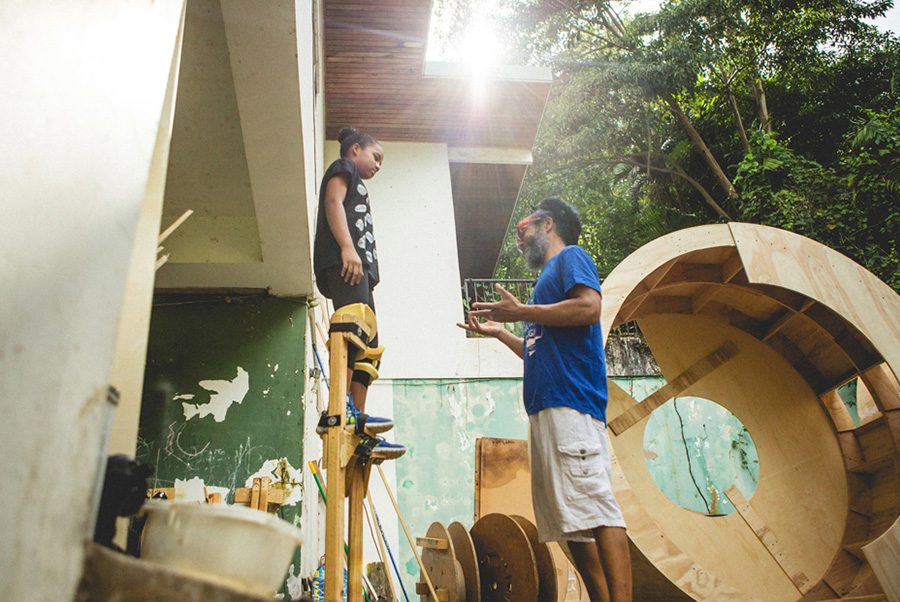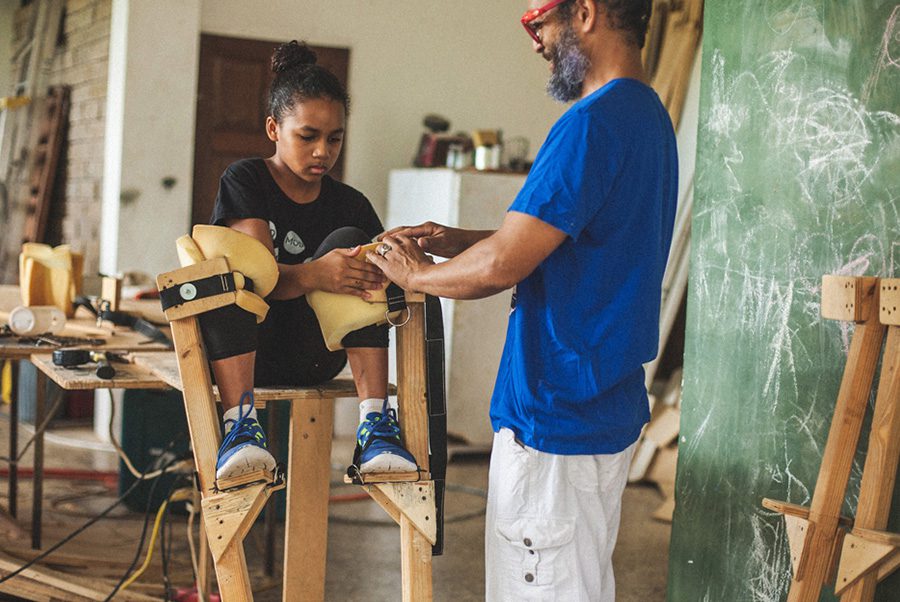

February 04, 2017
“This is how you know the culture isn’t dead.”
That was the comment I overheard as I listened to Bishop’s Girls’ perform Parang songs at a Christmas event back in November (mental note taken and tucked into a pocket of my mind). Fast-forward to January 2017, the beginning of Carnival Season in Trinidad and Tobago. Sitting on a makeshift worktable in the open-air studio of architect and designer Michael Lee Poy, nervously waiting to try his newly designed, quick-release Moko Jumbie stilts!
Moko legs are made for dancing!
I learned this the hard way as I balanced atop a pair of 2ft stilts.
Without constant movement learners can easily lose their balance and fall (another note taken and tucked). With a little practice, music and a lot of support, I was soon walking on my own. The stilts felt secure and sturdy, like extensions to my own legs that knew just how to punish me if I didn’t practice good posture.
The stilts were made of 2×2 pine, sanded with the edges softened; platforms of ¾” plywood (¼” thick aluminum angles for taller lengths) were cut to shape, glued and screwed into the stick; steel D-loops and velcro sewed to webbing secured my feet like a sandal and sponge padding attachments acted as knee pads. Designed for comfort and convenience.
“I want to make a better stilt, a light one… I want to support better costuming and a better mas” – Lee Poy said of the new quick-release stilt.
The stilts were born from a collaboration with Sam Mollineau of the Callaloo Company. Mollineau co-collaborated in the design and fabrication of the quick release system.
Designing for Moko Jumbies is not Lee Poy’s core work but neither is this new to him. Lee Poy designed for Moko Jumbie costumes and performances in Cleveland, USA and in 2015 where he was a finalist for the Prime Minister’s Award for Scientific Ingenuity with his ‘Jumbie Stiletto’. The ‘Jumbie Stiletto’ is a metal shoe with spikes and a rubber sole that attaches to the bottom of the stilt leg providing the performer with added grip for control and stability. He designed and fabricated the first Moko Jumbie King of Carnival for Mac Farlanes band in 2008 entitled Pandemic Rage – a 250 lbs. structure strapped to a backpack on 8ft stilts.
After witnessing Moko Jumbie veteran, Jhawan Thomas fall at the end of performances due to liquid or debris on the Savannah stage, the Jumbie Stiletto emerged as a design solution.
Continuous change is important, like the constant movement of stilt walking. If we want cultural practices, traditions and art forms to live on, the next generation needs to adopt them and we need to evolve their practice. This has been true for our dialects, music and other art forms.
“If a general is ignorant of the principle of adaptability, he must not be entrusted with a position of authority.” – Tu Yu, The Art of War, Sun Tzu
The story is told of an army that redesigned all its bows and arrows so that a warrior could use any arrow from a fellow fallen soldier where previously, arrows were made specially for the warrior’s personal bow and could not be shared. The redesigned bows and arrows helped the army win the war. A similar principle of adaptability is baked into the design of the quick release stilt. Some stilts are designed with the shoe bolted into the platform base of the stilt. This means that only the owner or someone with the same shoe size can wear the shoe and use that stilt. The design modification of bolted platforms with attached D-ring and velcro/webbing straps allows for a shoe on any person to be easily secured to the platform or removed. This makes it easy to exchange and share and also means that a child can continue to use his/her stilts through a longer period of change and growth.
Another popular method for wearing stilts includes wrapping the stilt and leg of the wearer together with cloth. It can be a tedious and time-consuming process that can require the wearer to have a helper. While patience and cooperation can be good values to learn, popular culture teaches children and youth to expect and want independence and quick results. Design can respond to changing times and needs by making the dressing process autonomous and reducing the amount of time required. The quick release design was inspired by a workshop Lee Poy held for 16 standard 5 students at Holistic Primary School in Port of Spain last year and the necessity to quickly mount students during a school period. By prioritizing an inclusive and child-friendly approach, design can provide new opportunities of accessibility and ease of use for people of all ages.
The young bird does not crow until it hears the old ones – Tswana African proverb
Mas designer Peter Minshall’s Dying Swan, performed by Jhawan Thomas, presented an evolution of the Moko Jumbie in an unforgettable artistic performance that embraced the history and practice of stilt walking and fused it with the realities of a diverse society.
Design facilitates change, supports evolution and can be a powerful tool in our arsenal for the arts.
In the Dying Swan, stilt dancing and ballet had a love child in the design of stilts en pointe. The Moko Jumbie came to life at the intersection of mas, art and design, presenting a challenge to traditional portrayals yet honoring and celebrating the art form with a portrayal that was different both in method and message.
“Change can be painful. Challenging tradition is controversial, but both are necessary and design is critical for a successful evolution.”



WRITER: DEBBIE ESTWICK PHOTOGRAPHER: KIBWE BRATHWAITE ARCHITECT + DESIGNER: MICHAEL LEE POY